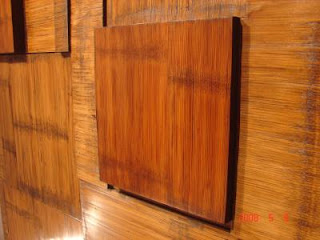TheDesignDevoted was created by Jan Lee. This blog will highlight outstanding design for residential and commercial interiors.
Sunday, December 2, 2012
I knew when I discovered antique Chinese sleeping mats in my travels that I would find a way to make them into something beautiful. I spent several years gathering the mats from villages in Southern China. They range in age from 25 years to 100 years old and retain their warm patina and markings from daily use. They are made up of hundreds of thin bamboo slivers about as thick as a match stick and measure 36” – 40” wide on average and approximately six feet in length. The mats were made and used in the hot climate of Southeast Asia for sleeping on. They cool the body naturally by wicking away moisture.
The process in making a Chinese sleeping mat is a laborious one. First, a skilled craftsman chooses a large and mature bamboo stalk to yield long straight “sticks”. The stalk is then carefully split lengthwise into hundreds of individual sticks. Each stick is placed side-by-side and a tiny hole is drilled laterally to accept a cotton string which will be strung through the entire length of the mat and doubled back.
This is repeated throughout the mat with even spacing between strings. There are no visible knots as the strings are knotted inside of the mat to avoid unraveling. Miraculously very few mats actually unravel over time, the strings stay taught and the mats are flexible enough to be rolled up and unrolled for decades.
These mats are very different than the engineered bamboo you see today which is used for flooring or furniture veneer. That product is cut, planed, flattened and glued by machines and is uniform throughout. Antique Chinese sleeping mats have varying thicknesses and each is cut slightly different in size. Occasionally a mat will have a burn mark from incense or an opium pipe carelessly placed upon it, this adds to the markings that make each mat unique. In collecting these mats I learned from the older people in the community that they used to unroll them and sleep on them and then roll them up again the morning after wiping them down. Chinese people of earlier generations tended to sleep on harder surfaces than today, sometimes even hard wooden boards with these mats offering a modicum of “cushion”. In rural farming communities beds may consist of two sawhorses with boards across them with bamboo mats. I was told lucky families had three sawhorses per bed. The horses, boards and mats would all be stored during the day, and the floor space would be resume use as a kitchen, dining room, living area and more.
For a decade now I have used this amazing material as a veneer for my furniture. It offers great variety of color, depth and character. When combined with solid wood or wood veneers the bamboo is highlighted for its unique texture. It takes a skilled hand to work with this material because unlike machine made bamboo or wood veneer every single mat is unique in thickness and dimension. The color and character of every single mat is also unique making every project truly one of a kind. Come by my workshop and I’ll show you the many varieties of color and texture this beautiful material will yield. Contact: Jan Lee (917) 710-7503
Subscribe to:
Post Comments (Atom)






No comments:
Post a Comment